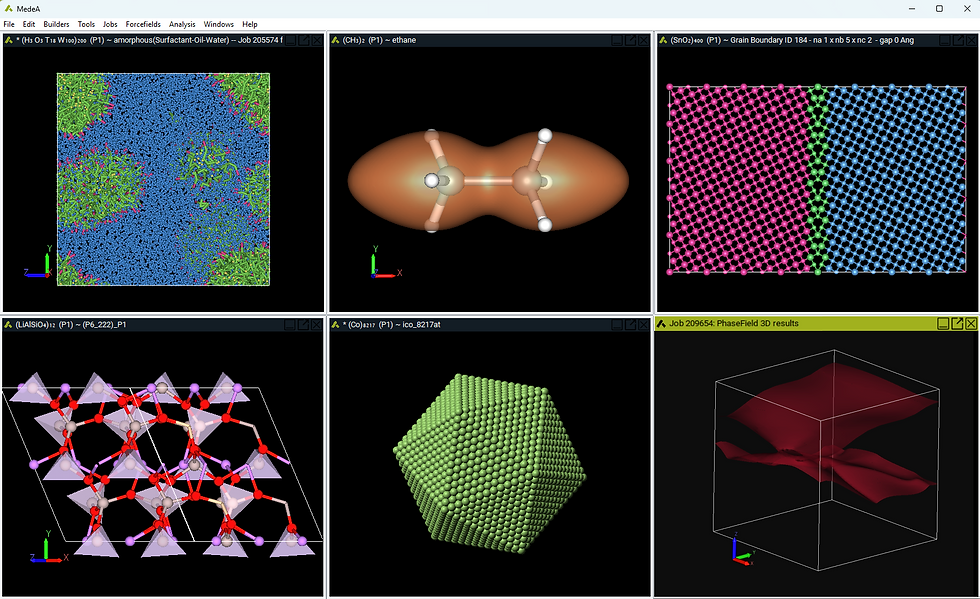New Software Release: MedeA 2.22 Unlock the Code
- Katherine Hollingsworth
- Dec 7, 2017
- 4 min read

Materials Design, Inc. announces the release of MedeA version 2.22.
The release of MedeA 2.22 includes:
Updated versions of compute engines VASP, GIBBS, LAMMPS, GAUSSIAN, and MOPAC, accelerating performance and providing many new properties and features
Builder capability extensions – enhancing model construction and accelerating simulation studies
Updates to the MedeA Forcefield library with many new forcefield types and parameter sets and extensions broadening coverage and improving simulation accuracy for many materials
Database updates and enhancements providing access to the latest in materials science information
MedeA runs natively in 64-bit mode both on Windows and Linux operating systems.
The release of MedeA software version 2.22, allows the user to:
Benefit from using updated versions of all the MedeA environment compute engines, with many new features and incorporating improvements in computing performance.
VASP 5.4.4 automated computational protocols provide response functions including electron-hole excitonic effects, accurate correlation energies from the random phase approximation, as well as new meta-GGA and van der Waals functionals, efficiently and straightforwardly delivering advanced calculations.
GIBBS 9.6.2 handles flexible multi-cyclic molecules opening new perspectives in property prediction for compounds of interest to a broad range of industries.
MedeA-UNCLE cluster-expansion engine extends the predictive power and accuracy of ab-initio methods to efficient large scale modeling of disordered systems, and now enables simulations for multi component alloys and surfaces, permitting the study of high-entropy alloys, surface segregation and surface coverage of adsorbents.
Efficiently build complex models, with the extension of the capabilities of the Thermoset
Builder to allow control over relative probabilities of crosslink formation at sites capable of reacting multiple times and improve creation of large numbers of thermosets using Flowcharts and High-Throughput features.
Have increased simulation coverage and accuracy from the addition of new types of forcefields
for molecular dynamics (ReaxFF, MEAM, REBO, and Streitz-Mintmire) and the extensions to existing forcefields for molecular dynamics and Monte Carlo (pcff+, TraPPE-UA+, mie).
MedeA 2.22 - New Capabilities
“This MedeA release unlocks cutting edge simulations with the latest generation of compute engines.” says Clive Freeman, CEO of Materials Design, Inc. “MedeA supplies up-to-date and thoroughly validated capabilities providing straightforward access to advanced methods opening tremendous opportunities in materials science research and development and high-throughput simulation.”
MedeA is the leading professional software environment for atomistic materials modeling used at more than 500 customer sites worldwide. Scientists and engineers in industry and research institutions use MedeA to understand complex processes such as mechanical failure, electrochemistry and ionic conductivity in batteries, and catalytic reactions; and to compute materials properties efficiently and systematically. MedeA helps to create better products while saving valuable research and development time and cost.
The new release, MedeA 2.22, offers a range of new capabilities and enhancements as follows:
MedeA-VASP:
Latest release, VASP 5.4.4, is introduced
Very accurate total energies from exact exchange and many-body correlation via ACFDT-RPA, as obtained from a fully automated computational protocol
Electronic response functions including electron-hole interactions by solving the Bethe-Salpeter equation on top of a GW quasiparticle calculation, as delivered by a multi-step computational protocol
Automated protocol for optical spectra including excitonic effects from time-dependent hybrid functionals (or TD-DFT) by solving the Casida equation
New meta-GGA functionals: SCAN, MS0, MS1, and MS2
New van der Waals functionals: BEEF-vdW, rev-vdW-DF2 (Hamada), SCAN + rVV10
New van der Waals forcefields: Many-body dispersion energy, DFT + dDsC
Advanced option to enable site- and atom-resolved (rather than default element-resolved) definition of potentials, U and J parameters, core holes etc.
Spin-polarized calculations constraining the total magnetic moment
Enhanced output options
VASP High-Throughput is aligned with the VASP 5.4 GUI settings
MedeA-GIBBS:
New version 9.6.2
Extended capabilities to treat flexible/semi-flexible multi-cyclic molecules
Mie potential and Lafitte mixing rule introduced
MedeA-LAMMPS:
New version (2017)
Atoms can be partly frozen (x/y/z)
Charge equilibration is turned on by default for charge transfer forcefields (COMB3, Streitz-Mintmire, and ReaxFF)
MedeA-MOPAC:
New version (2016) of MOPAC
MedeA-GAUSSIAN:
New version (2016) of GAUSSIAN supported
MedeA-InfoMaticA & Databases:
Update of COD database
Update of Pearson database
MPDS
MedeA-Thermoset Builder:
Substitution effect (control over relative probabilities of crosslink formation at sites capable of reacting multiple times)
Archival of snapshots of the periodic models during model build
MedeA-HT:
HT Launchpad enhanced parallelization and workflow capabilities
HT Descriptors extended descriptor and reporting functionality
MedeA-UNCLE:
Surface cluster expansion and Monte Carlo (applications for surface segregation, coverage of adsorbents, catalysis)
Automatic default or custom settings dedicated to multinary cluster expansion optimization
MedeA-Phonon:
Refined temperature grid for thermodynamic functions
Thermal displacement tensors for all lattice sites
MedeA-Forcefields:
PCFF+:
New parameterization for hydroxide ions (LJ parameters, partial charges and bond stretch)
Extension of parameterization (angle-angle term) for imide 5-membered rings
New forcefield parameters for boron-nitride
Enhancements and refinements for dimethyl siloxanes
MEAM:
Addition of Modified Embedded Atom Method (MEAM) forcefield type
MEAM forcefields for Cu, Ni, W, AlSiMgCuFe, AuSi, CH, FeC, SiC, and FeTiC included in the forcefields’ library (for use in LAMMPS)
Streitz-Mintmire:
Addition of Streitz-Mintmire forcefield type (also known as Charge Transfer Ionic Potentials).
Streitz-Mintmire forcefields for actinides-O, Al/Al2O3, and Ta/Ta2O5 included in the forcefields’ library.
ReaFF:
Addition of Reactive Forcefield (ReaxFF) forcefield type
ReaxFF forcefields for AuOH, CHO (combustion), CHON (nitramines), CHONSFPtClNi, FeCHO, HONB, VCHO, and ZnOH included in the forcefields’ library.
REBO:
Addition 1st generation Reactive Bond Order Potential (REBO) forcefield type
1st generation REBO forcefield for SiClAr included in the forcefields’ library.
TraPPE-UA+:
Multiple extensions for TraPPE-FullyFlexible, for polycyclic compounds (aromatic, naphthenic and naphthenoaromatic)
MedeA-FFO:
FFO extensions to handle explicit charge optimization
Enhancements for BKS forcefield optimization
Extensions to Bonny spline-based EAM forcefields
MedeA-JobServer and MedeA-TaskServer:
Platform Support: MedeA 2.22 is supported on 64 bit Windows and 64 bit Linux operating systems.




Comments